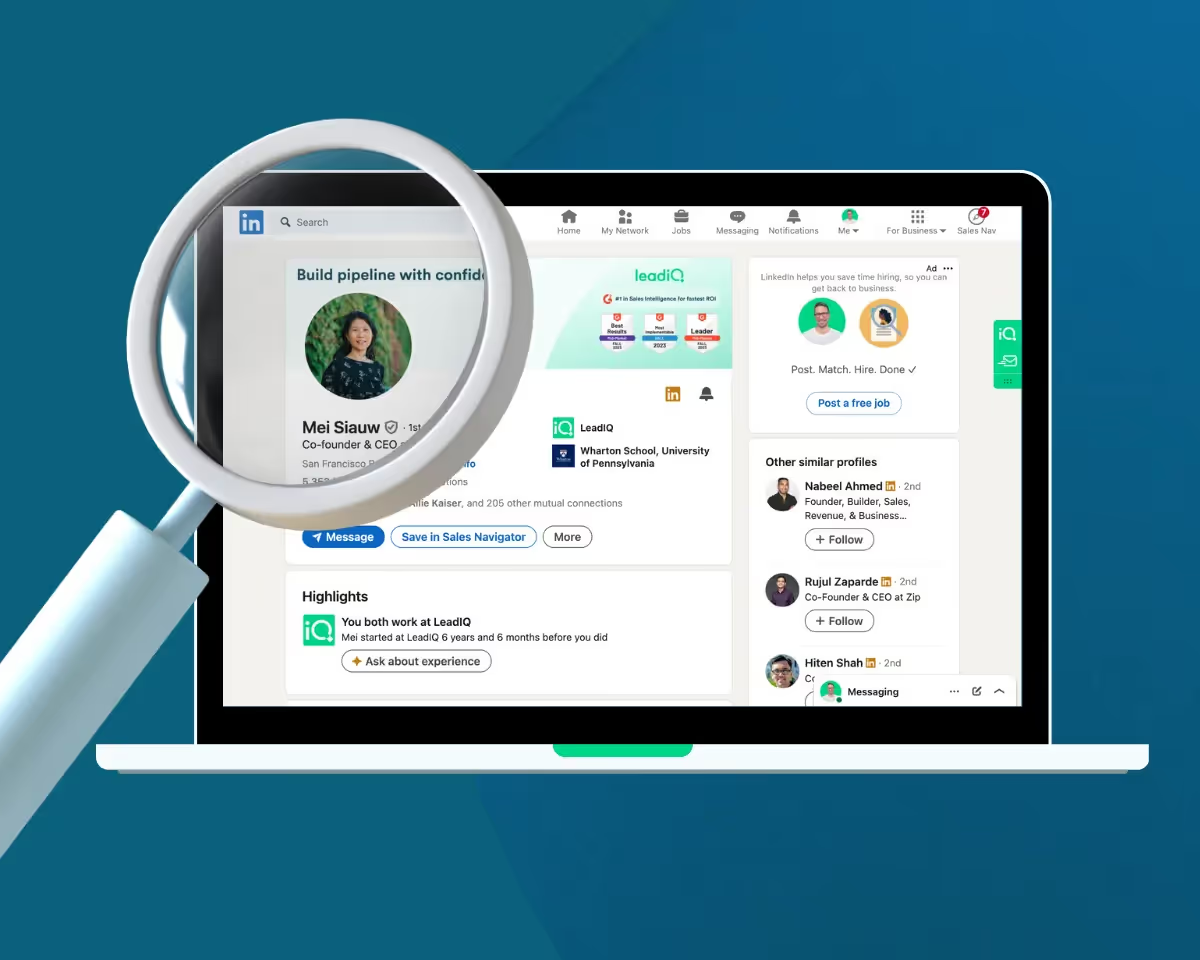Ready to create more pipeline?
Get a demo and discover why thousands of SDR and Sales teams trust LeadIQ to help them build pipeline confidently.



Achieving success with cold outreach starts with personalization

By conducting sales prospecting research, you can learn more about prospects and personalize emails based on individual, company, and industry elements

Researching prospects efficiently requires the right tools and knowing where to look for relevant data
Get a demo and discover why thousands of SDR and Sales teams trust LeadIQ to help them build pipeline confidently.
In the highly competitive world of SaaS sales, knowing a prospect’s pain points and business challenges is crucial for effective cold outreach.
While identifying these issues allows sales teams to position their products and services as solutions to the problems, calling attention to them shows prospects that you understand their needs and have done the legwork needed to truly understand their situation.
How exactly can you learn about the struggles your prospects are dealing with every day?
Easy: By conducting sales prospecting research, you can collect the detailed information you need about potential clients before initiating outreach — and adjust your cold email messaging accordingly.
Cold outreach is hard enough as it is. If you’re firing out generic messages to strangers at random, it’s virtually impossible.
At a high level, sales prospecting research helps reps learn more about prospects in a way that captures their attention. By conducting sales account research, reps can tailor their outreach to each individual prospect, ensuring that messaging includes something related to themselves, their role, or their industry or company — which can lead to more meaningful connections. After all, everyone knows what it feels like to receive a cold email that is entirely irrelevant.
In an age where consumers increasingly demand personalization, sales prospecting research can go a long way toward meeting the expectations of potential customers while building credibility and trust. By demonstrating a deep understanding of a prospect’s circumstances, it proves that you’re doing your homework and are genuinely interested in providing value.
At the same time, sales prospecting research also helps reps anticipate objections and prepare effective responses. This, in turn, makes conversations more productive and helpful — increasing the likelihood reps can move prospects through the funnel.
As you begin your cold email research, there are three levels of personalization to be on the lookout for: individual, company, and industry.

Individual personalization refers to customizing messages that address the specific interests, needs, and experiences of each prospect. Using this approach is an easy way to demonstrate that your outreach isn’t generic but rather a thoughtful effort to connect on a personal level — which can help your cold outreach messages stand out. By showing a deep understanding of the prospect’s unique situation, you can increase the likelihood of a positive response.
Examples of elements you can use to personalize outreach on an individual level include:
Company personalization involves creating messages that reference the unique characteristics, challenges, and goals of the company, along with any recent news (e.g., a fundraising round, a new hire, or a product launch). By addressing the company’s particular pain points or recent wins, you can demonstrate relevance right out of the gate.
Here are some ways you can personalize outreach using company data:
Industry personalization refers to crafting messages that address the specific challenges, trends, and opportunities that exist in the target prospect’s industry. By demonstrating a deep understanding of industry context, you can make your outreach more relevant and insightful. At the same time, you can also highlight how your solution aligns with industry-specific needs, increasing the chances you capture the prospect’s interest.
Here are some elements you can personalize on the industry level:
Using sales prospect research to improve cold email personalization can help you sell more. But where exactly should you invest your energy when trying to track down relevant information? Let’s take a look.
Your CRM contains a wealth of information you can use to personalize your outreach. So, start your research process by reviewing notes about each account in your CRM to understand previous interactions and preferences.
While you’re at it, use conversational intelligence tools like Gong and call tracking data to glean insights from past communication, saving you time while giving you the data you need to formulate a strategy. Many CRMs — including Salesloft Rhythm and Gong Engage — offer AI-driven insights that can speed up your research by automatically analyzing interactions and giving you suggestions on how to tailor your outreach.
Data and insight aggregators can be super helpful in sales prospecting research. By consolidating diverse sources, these tools provide comprehensive data on prospects’ behavior, preferences, and industry trends that you can use to create informed outreach strategies.
For example, LeadIQ Scribe Insights automatically pulls up relevant information about prospects and puts it right at your fingerprints — things like LinkedIn bios, podcasts, company news, job postings, earnings calls, and financial reports. Whether you’re using the LeadIQ Chrome extension or writing emails elsewhere using Scribe, you can access all of this data in just a few clicks — making personalization a breeze.
Similarly, LinkedIn Sales Navigator offers Account IQ, which also provides insights into target accounts. While I’m biased toward LeadIQ, I encourage each of my reps to use Account IQ regularly to surface the insights they need to engage prospects more effectively. New to Account IQ? Learn more about how you can use Account IQ to hit your numbers faster.
Feel like you need more data to personalize your outreach? Here are some other sources to check out:
When it comes to SaaS sales success, personalization is the key to finding pipeline and driving more sales.
At LeadIQ, we’re all about helping sales teams prospect as efficiently as possible. Using LeadIQ, reps can surface the insights they need to effectively engage prospects — all in just a few clicks.
To see how LeadIQ can transform the way you conduct sales prospecting research, take our platform for a test drive today.